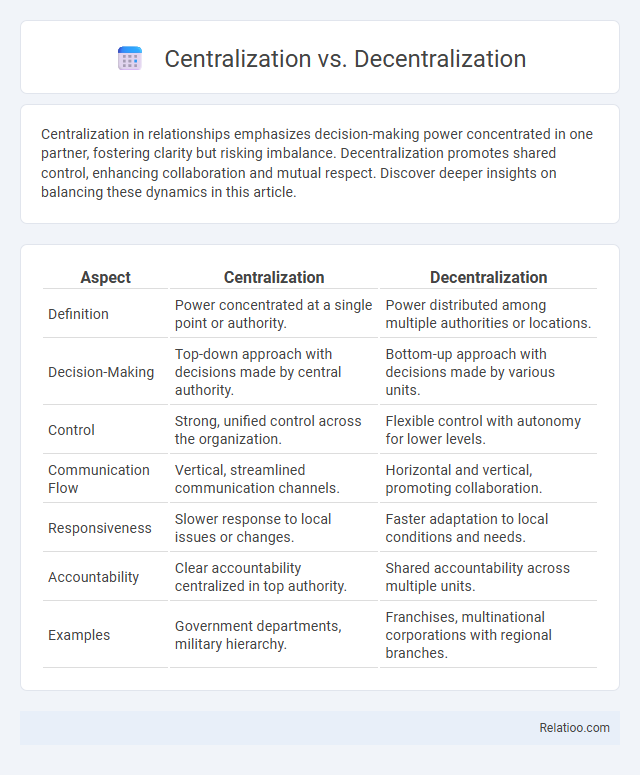Centralization in relationships emphasizes decision-making power concentrated in one partner, fostering clarity but risking imbalance. Decentralization promotes shared control, enhancing collaboration and mutual respect. Discover deeper insights on balancing these dynamics in this article.
Table of Comparison
| Aspect | Centralization | Decentralization |
|---|---|---|
| Definition | Power concentrated at a single point or authority. | Power distributed among multiple authorities or locations. |
| Decision-Making | Top-down approach with decisions made by central authority. | Bottom-up approach with decisions made by various units. |
| Control | Strong, unified control across the organization. | Flexible control with autonomy for lower levels. |
| Communication Flow | Vertical, streamlined communication channels. | Horizontal and vertical, promoting collaboration. |
| Responsiveness | Slower response to local issues or changes. | Faster adaptation to local conditions and needs. |
| Accountability | Clear accountability centralized in top authority. | Shared accountability across multiple units. |
| Examples | Government departments, military hierarchy. | Franchises, multinational corporations with regional branches. |
Understanding Centralization: Definition and Key Features
Centralization refers to the concentration of decision-making authority within a single point or a small group in an organization, allowing for uniformity and streamlined control. Key features include a clear hierarchy, centralized communication channels, and tight oversight, which facilitate consistency in policies and procedures. Understanding centralization helps you evaluate its impact on organizational efficiency, control, and responsiveness.
Decentralization Explained: Core Principles and Benefits
Decentralization distributes decision-making authority from central leadership to lower levels within an organization, enhancing flexibility and responsiveness. Core principles include autonomy, transparency, and local accountability, enabling units to tailor strategies to specific needs. Benefits encompass increased innovation, faster decision cycles, and improved employee motivation through empowerment and ownership.
Historical Evolution of Centralization and Decentralization
The historical evolution of centralization reveals a trend where early civilizations established strong centralized governments to maintain control and coordinate resources efficiently, as seen in ancient Egypt and Mesopotamia. Decentralization emerged later as societies expanded, promoting local autonomy and distributing power to regional authorities to better address diverse community needs, exemplified by the Roman Republic's system of governance. Your understanding of these shifts helps illuminate how the balance between central control and decentralized autonomy shapes political and organizational structures today.
Advantages of Centralized Systems
Centralized systems offer streamlined decision-making processes, enabling faster implementation of strategies and consistent policy enforcement across an organization. Their unified control enhances resource allocation efficiency and reduces redundancy, leading to better cost management. By centralizing authority, your organization benefits from clear accountability and improved coordination among departments.
Benefits of Decentralized Models
Decentralized models enhance organizational agility by distributing decision-making power closer to operational levels, which improves responsiveness and innovation. Your teams benefit from increased autonomy, fostering motivation and accountability that drive performance and engagement. By reducing bottlenecks inherent in centralized structures, decentralized systems promote resilience and scalability in dynamic markets.
Common Challenges in Centralization
Centralization often faces challenges such as reduced organizational agility, limited employee autonomy, and bottlenecks in decision-making processes, which can hinder innovation and responsiveness. Centralized structures may create dependencies on key individuals or departments, leading to inefficiencies during high-demand periods or crises. These issues contrast with decentralization and disempowerment, where decision authority and responsibility are distributed more broadly or withheld, respectively, affecting overall operational dynamics.
Typical Drawbacks of Decentralized Structures
Decentralized structures often face challenges such as inconsistent decision-making and prolonged response times due to the dispersion of authority across multiple units. Your organization may experience difficulties in maintaining uniform policies and standards, which can lead to inefficiencies and coordination problems. Furthermore, decentralized systems risk weakened accountability and increased operational costs compared to centralized models.
Centralization vs Decentralization: Impact on Decision-Making
Centralization consolidates decision-making authority at the top levels of management, leading to uniform policies and faster execution in controlled environments. Decentralization distributes authority across various organizational levels, fostering greater flexibility, quicker responses to local issues, and enhanced employee empowerment. The choice between centralization and decentralization critically influences organizational agility, communication flow, and the capacity for innovation in decision-making processes.
Real-World Examples: Centralized vs Decentralized Organizations
Centralized organizations like Apple maintain tight control over decision-making, enabling uniform brand messaging and rapid implementation of strategies, which enhances efficiency in product development. In contrast, decentralized companies such as Toyota empower regional branches to make autonomous decisions, fostering innovation and adaptation to local markets while increasing responsiveness. Disempowerment occurs in overly centralized structures where employees lack autonomy, leading to decreased motivation and slower problem-solving, as seen in some rigid government agencies.
Choosing the Right Approach: Factors to Consider
Choosing the right approach between centralization, decentralization, and disempowerment depends on factors such as organizational size, decision-making speed, and employee autonomy. Centralization offers streamlined control and consistency, while decentralization enhances flexibility and responsiveness across departments. You must balance these elements to optimize efficiency, innovation, and accountability within your specific business environment.

Infographic: Centralization vs Decentralization
 relatioo.com
relatioo.com